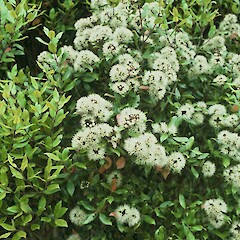Metrosideros bartlettii
Common name
rātā moehau, Bartlett’s rātā
Synonyms
None
Family
Myrtaceae
Flora category
Vascular – Native
Endemic taxon
Yes
Endemic genus
No
Endemic family
No
Structural class
Trees & Shrubs - Dicotyledons
NVS code
The National Vegetation Survey (NVS) Databank is a physical archive and electronic databank containing records of over 94,000 vegetation survey plots - including data from over 19,000 permanent plots. NVS maintains a standard set of species code abbreviations that correspond to standard scientific plant names from the Ngä Tipu o Aotearoa - New Zealand Plants database.
METBAR
Chromosome number
2n = 22
Current conservation status
The conservation status of all known New Zealand vascular plant taxa at the rank of species and below were reassessed in 2017 using the New Zealand Threat Classification System (NZTCS) – more information about this can be found on the NZTCS website. This report includes a statistical summary and brief notes on changes since 2012 and replaces all previous NZTCS lists for vascular plants.
Please note, threat classifications are often suggested by authors when publications fall between NZTCS assessment periods – an interim threat classification status has not been assessed by the NZTCS panel.
- Conservation status of New Zealand indigenous vascular plants, 2017 . 2018. Peter J. de Lange, Jeremy R. Rolfe, John W. Barkla, Shannel P. Courtney, Paul D. Champion, Leon R. Perrie, Sarah M. Beadel, Kerry A. Ford, Ilse Breitwieser, Ines Schönberger, Rowan Hindmarsh-Walls, Peter B. Heenan and Kate Ladley. Department of Conservation. Source: NZTCS and licensed by DOC for reuse under the Creative Commons Attribution 4.0 International licence.
2017 | Threatened – Nationally Critical | Qualifiers: CD, RR, RF
Previous conservation statuses
2012 | Threatened – Nationally Critical | Qualifiers: CD, RR
2009 | Threatened – Nationally Critical | Qualifiers: CD, RR
2004 | Threatened – Nationally Critical
Brief description
Forest tree (up to 30 m tall). Bark grey-white to white, spongy, tissue-like, and readily flaking. Emergent leaves yellow-green, mature leaves dark green, margins distinctly hairy. Inflorescences white.
Distribution
Endemic. North Island, Northland, Te Paki, where it is only known from three forest remnants near Spirits Bay. These are Radar Bush, Kohuronaki and Unuwhao Bush.
Habitat
An emergent or canopy tree of northern coastal and lowland broad-leaved forest. Usually starting life as an epiphyte on puriri (Vitex lucens), taraire (Beilschimedia tarairi ), rewarewa (Knightia excelsa) and tree ferns (Cyathea spp.). Occasional specimens have been found growing terrestrially on rock outcrops, boulders and cliff faces.
Detailed description
Tree up to 30 m with a trunk up to 1.5 m diameter, often initially epiphytic on trees or tree ferns; bark pale grey to whitish, spongy, separating into soft flakes, shedding freely; young twigs dark red, 4-angled to rounded and with long-persistent, white spreading hairs. Leaves on petioles 4–5 × 1 mm, lamina 30–50 × 15–26 mm, elliptic to ovate, base cuneate, apex acute to attenuate, often twisted; young leaves pale green to yellow-green, somewhat glossy, petioles, margins and midribs pubescent, with the hairs tending to persist on midribs and petioles; mature leaves dark green above pale beneath, upper surface glossy, veins evident, lower surface glossy, entire vein network evident, oil glands obscure, midrib raised below, impressed above. Inflorescences with 3-4 pairs of cymules, ± densely tomentose, tomentum of spreading white hairs; bracts and bracteoles shedding early during inflorescence maturation; peduncles up to 9 × 1 mm. Flowers white; pedicels up to 3 × 1 mm; hypanthium 2.5-3.0 ×2.0-2.5 mm; sepals triangular, spreading, 1.0–1.5 × 1.0–1.5 mm; petals elliptic to ovate, 2.5–3.0 × 1.8–2.0 mm; stamens 5–9 mm long; style 10–11 mm long. Fruit hypanthium puberulent, 2.0–2.5 × 2.5–3.0 mm, sepals persistent, deflexed, capsules exserted for 1.5–2.5 mm. Seeds pale orange-yellow, 2.3–3.0 mm long, narrowly elliptic to narrowly oblong, straight or slightly curved.
Manaaki Whenua Online Interactive Key
Similar taxa
Bartlett’s rata could only be confused with northern rata (Metrosideros robusta) from which it can immediately be distinguished by the acute tipped rather than notched leaves. The flowers of northern rata are red or yellow, never white, and the capsule valves of that species never protrude beyond the calyx rim. No other New Zealand Metrosideros has such easily detached, white, tissue-paper-like bark.
Flowering
October – November
Flower colours
White
Fruiting
March - April
Propagation technique
Easily grown from fresh seed. Can also be grown by hardwood cuttings but these can be slow to take root. Plants have proved tolerant of a wide range of conditions, and have survived mild frosts and even snow falls. However specimens do best in open, sunny sites within well drained, fertile soils.
Threats
As of 2015 there were 13 adult rata moehau left in the wild (down from the 34 known in 1992). Three trees occur on private land where they are isolated from other specimens. There is negligible viable seed set because there is not an abundance of nectar-feeding birds to pollinate the flowers and Bartlett’s rata is self-incompatible. There are now only five genotypes left in the wild, only one of which is widespread in cultivation. Aside from these problems, the species is at severe risk from browsing animals, fire and myrtle rust (Austropuccinia psidii). Rata moehau also supports two endemic liverworts, Frullania wairua and Siphonolejeunea raharaha-nehemiae, which are also now at severe risk of extinction.
Myrtle Rust (Austropuccinia psidii) is an invasive fungus which threatens native myrtle species - learn more myrtlerust.org.nz
Etymology
metrosideros: Iron heart
Attribution
Fact sheet prepared for NZPCN by P.J. de Lange (30 September 2003). Description adapted from Dawson (1985) supplemented with observations made from herbarium and fresh material.
References and further reading
Dawson , J.W. 1985: Metrosideros bartlettii (Myrtaceae) a new species from North Cape, New Zealand. New Zealand Journal of Botany 23: 607–610.
NZPCN Fact Sheet citation
Please cite as: de Lange, P.J. (Year at time of access): Metrosideros bartlettii Fact Sheet (content continuously updated). New Zealand Plant Conservation Network. https://www.nzpcn.org.nz/flora/species/metrosideros-bartlettii/ (Date website was queried)

















